
Radford is an independent city in the U.S. state of Virginia. As of 2010, the population was 16,408 by the United States Census Bureau. For statistical purposes, the Bureau of Economic Analysis combines the city of Radford with neighboring Montgomery County.

Spencer is a city in and the county seat of Roane County, West Virginia, United States. Originally known as "California," Spencer was chartered in 1858, and named after Spencer Roane (1762–1822), a distinguished jurist from Virginia, who served on the Virginia Supreme Court of Appeals, and for whom Roane County was named. The population was 2,322 at the 2010 census. Spencer is the home of the annual West Virginia Black Walnut Festival. Points of interest include Charles Fork Lake, Chrystal Water and Power Company-Spencer Water and Ice Company, the McIntosh Mansion, and the Robey Theatre.

Natural Bridge is a geological formation in Rockbridge County, Virginia, comprising a 215-foot-high (66 m) natural arch with a span of 90 feet (27 m). It is situated within a gorge carved from the surrounding mountainous limestone terrain by Cedar Creek, a small tributary of the James River. Consisting of horizontal limestone strata, Natural Bridge is the remains of the roof of a cave or tunnel through which the Cedar Creek once flowed.
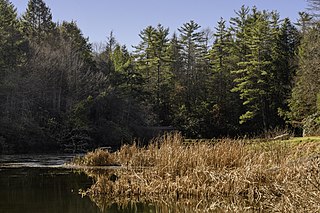
Little Beaver State Park is state park in Raleigh County, West Virginia. It is located near Beckley, West Virginia, about 2 miles (3.2 km) south of I-64 at Grandview Road, exit 129A. The park sits on the shores of 18-acre (0.07 km²) Little Beaver Lake.

Ice Mountain is a mountain ridge and algific talus slope that is part of a 149-acre (60 ha) preserve near the community of North River Mills in Hampshire County, West Virginia, United States. It was designated a National Natural Landmark in 2012.
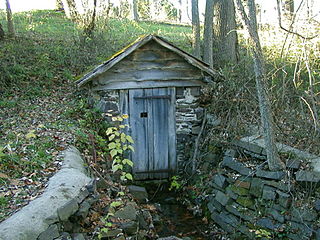
A spring house, or springhouse, is a small building, usually of a single room, constructed over a spring. While the original purpose of a springhouse was to keep the spring water clean by excluding fallen leaves, animals, etc., the enclosing structure was also used for refrigeration before the advent of ice delivery and, later, electric refrigeration. The water of the spring maintains a constant cool temperature inside the spring house throughout the year. Food that would otherwise spoil, such as meat, fruit, or dairy products, could be kept there, safe from animal depredations as well. Springhouses thus often also served as pumphouses, milkhouses, and root cellars.

The Holyoke Canal System is a system of power canals in Holyoke, Massachusetts. It is split into three canals based on elevation and distance from the inlet at the Holyoke Dam- the First Level Canal, Second Level Canal, and Third Level Canal. Constructed over a period between 1847 and 1892, the Canal System, along with the Dam, is recognized as a Historic Mechanical Engineering Landmark by the American Society of Mechanical Engineers for its use in the development of the Venturi meter by Clemens Herschel, the first means of measuring large-scale flows, and the McCormick-Holyoke Turbine by John B. McCormick, which doubled the efficiency of turbines to more than 80% in its time.
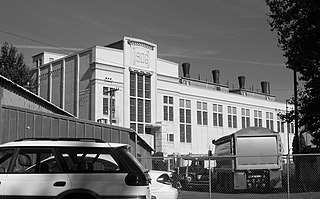
The Georgetown Steam Plant, located in the Georgetown neighborhood of Seattle, Washington, was constructed in 1906 for the Seattle Electric Company to provide power for Seattle, notably for streetcars.

Croton Dam is an earth-filled embankment dam and powerplant complex on the Muskegon River in Croton Township, Newaygo County, Michigan. It was built in 1907 under the direction of William D. Fargo by the Grand Rapids - Muskegon Power Company, a predecessor of Consumers Energy. The 40-foot-high (12 m) dam impounds 7.2 billion U.S. gallons (6 billion imp. gal/27 billion L) of water in its 1,209-acre (489 ha) reservoir and is capable of producing 8,850 kilowatts at peak outflow. It was listed on the National Register of Historic Places in 1979.
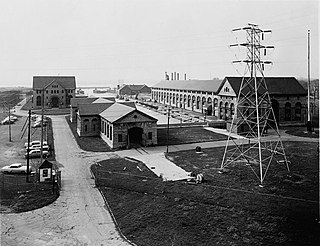
Adams Power Plant Transformer House in Niagara Falls, New York is a National Historic Landmarked building constructed in 1895. It is the only remaining structure that was part of the historic Edward Dean Adams Power Plant, the first large-scale, alternating current electric generating plant in the world, built in 1895. The building's eponym was Edward Dean Adams, a businessman and entrepreneur in the electrical field.
Ice plant or iceplant may refer to:

George Washington's Gristmill was part of the original Mount Vernon plantation, constructed during the lifetime of the United States' first president. The original structure was destroyed about 1850. The Commonwealth of Virginia and the Mount Vernon Ladies’ Association have reconstructed the gristmill and the adjacent distillery. The reconstructed buildings are located at their original site three miles (5 km) west of Mount Vernon proper near Woodlawn Plantation in Alexandria, Virginia. Because the reconstructed buildings embody the distinctive characteristics of late eighteenth century methods of production and are of importance to the history of Virginia, the site is listed on the National Register of Historic Places despite the fact that the buildings are not original.

Power Plant and Dam No. 5, also known as Honeywood Dam, comprises a dam on the Potomac River, originally built for the Chesapeake and Ohio Canal, and a power plant built to take advantage of the river's flow to generate hydroelectric power. The dam is included in Chesapeake and Ohio Canal National Historical Park.

Mechanicville Hydroelectric Plant is a 18.3-acre (7.4 ha) national historic district located at Mechanicville in Saratoga County, New York. The listing included one contributing building and three contributing structures. The district dates to 1897 and includes notable Queen Anne architecture.

Power Plant and Dam No. 4 is a historic hydroelectric power generation station on the Potomac River, located near Shepherdstown on the county line between Berkeley and Jefferson County, West Virginia. The power plant is a tall one-story, limestone building on a high stone foundation. It is five bays long and has a gable roof. Dam 4 uses horizontal shaft turbines connected by rope drives to horizontal shaft generators. This plant is probably the last commercially operated rope-driven hydroelectric plant in the United States. The building is built into a hillside, so the main floor is the top floor. The power plant was originally built by the Martinsburg Electric Company.
The Sego Milk Plant, also known as the Utah Condensed Milk Company Plant, was a historic factory located in Galt, Sacramento County, CA.

The Carver Industrial Historic District is a national historic district located at Carver, Richmond, Virginia. The district encompasses 13 contributing buildings located west of downtown Richmond. The industrial area developed between 1890 and 1930, along the tracks of the Richmond, Fredericksburg and Potomac Railroad. The buildings are in a variety of popular 19th-century and early 20th century architectural styles including Queen Anne and Romanesque.

The Bodwell Water Power Company Plant, also known as the Milford Plant of Emera Maine, is a hydroelectric power generation facility on the Penobscot River in Milford, Maine. Its main building, a handsome Romanesque structure, stands at the eastern end of the Milford Dam. Built in 1906, it was at that time the largest hydroelectric facility in the state, and its construction marked a shift from water to electrical power of area industries. It was listed on the National Register of Historic Places in 1988.
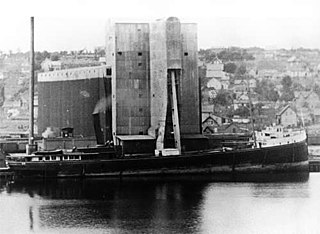
The George Spencer was a wooden lake freighter that sank on along with her schooner barge Amboy on Lake Superior, near Thomasville, Cook County, Minnesota in the Mataafa Storm of 1905. On April 14, 1994, the wrecks of the Spencer and the Amboy were listed on the National Register of Historic Places.
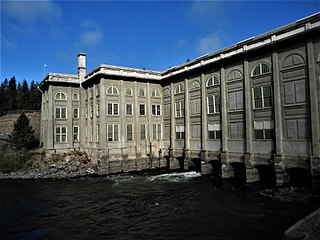
The Little Falls Hydroelectric Power Plant, on the Spokane River near Reardan, Washington, about 30 miles (48 km) west of Spokane was built during 1907–10. It was listed on the National Register of Historic Places in 1988. The listing included one contributing building and seven contributing structures on 12 acres (4.9 ha). The area spans the border of Lincoln County, Washington and Stevens County, Washington.




















